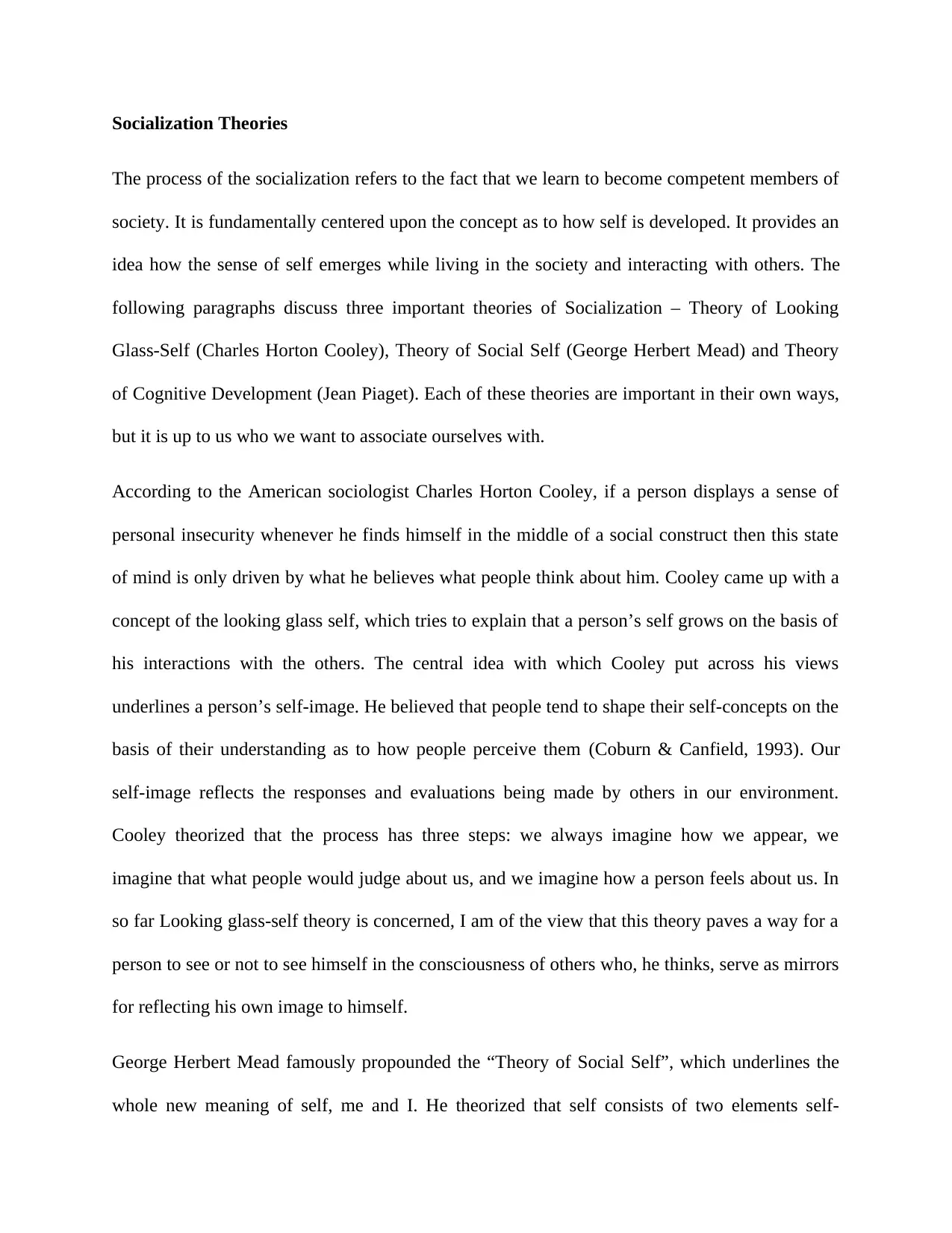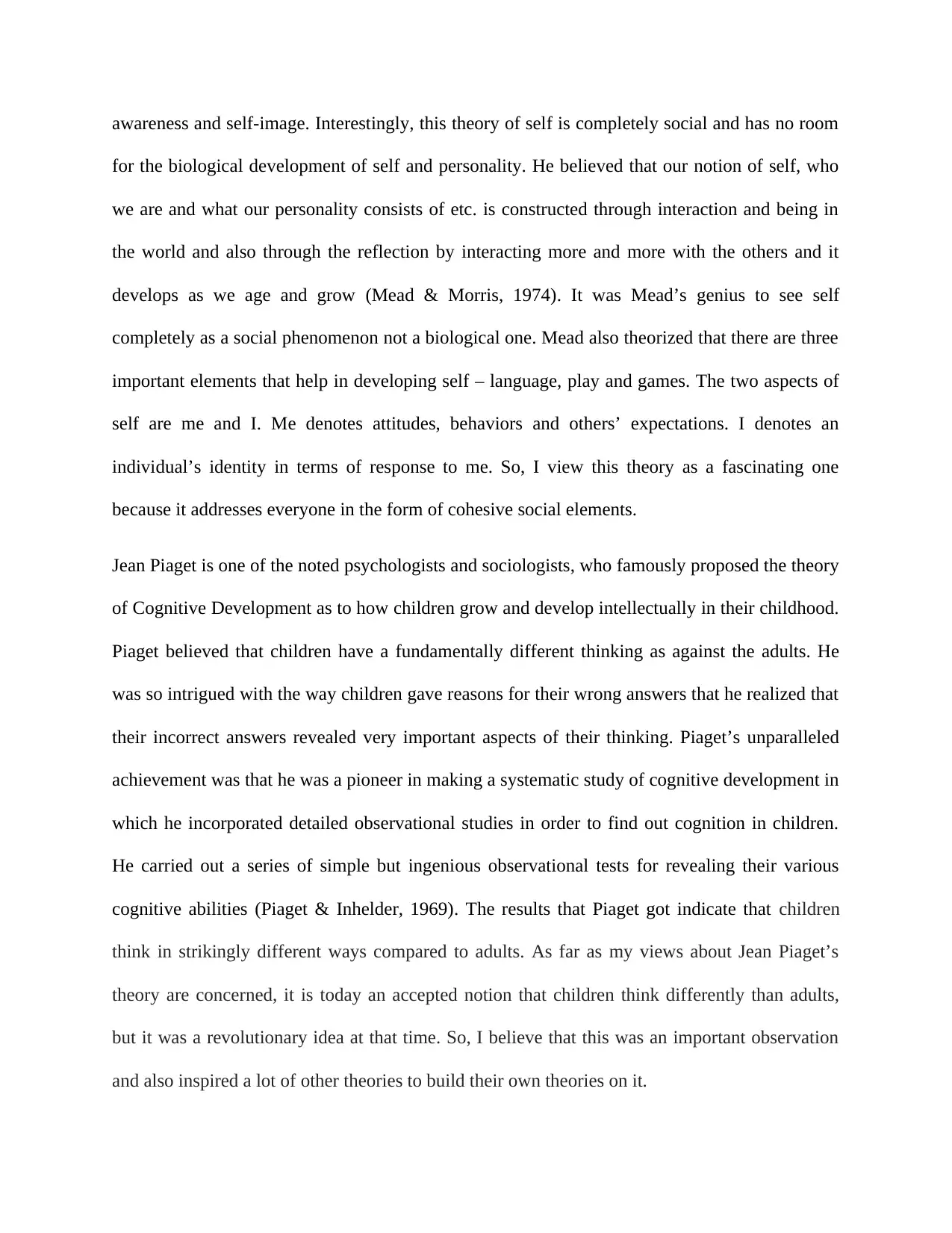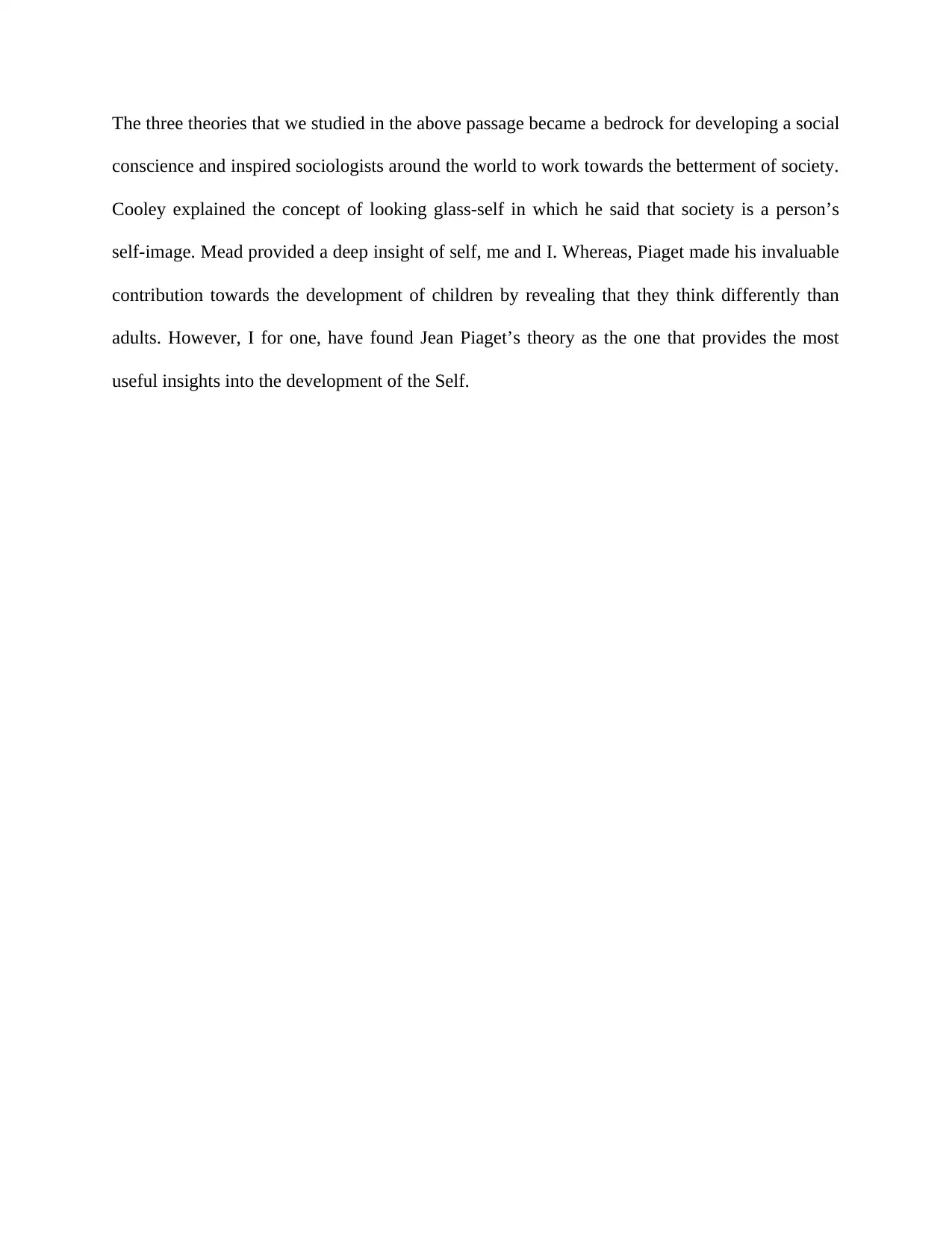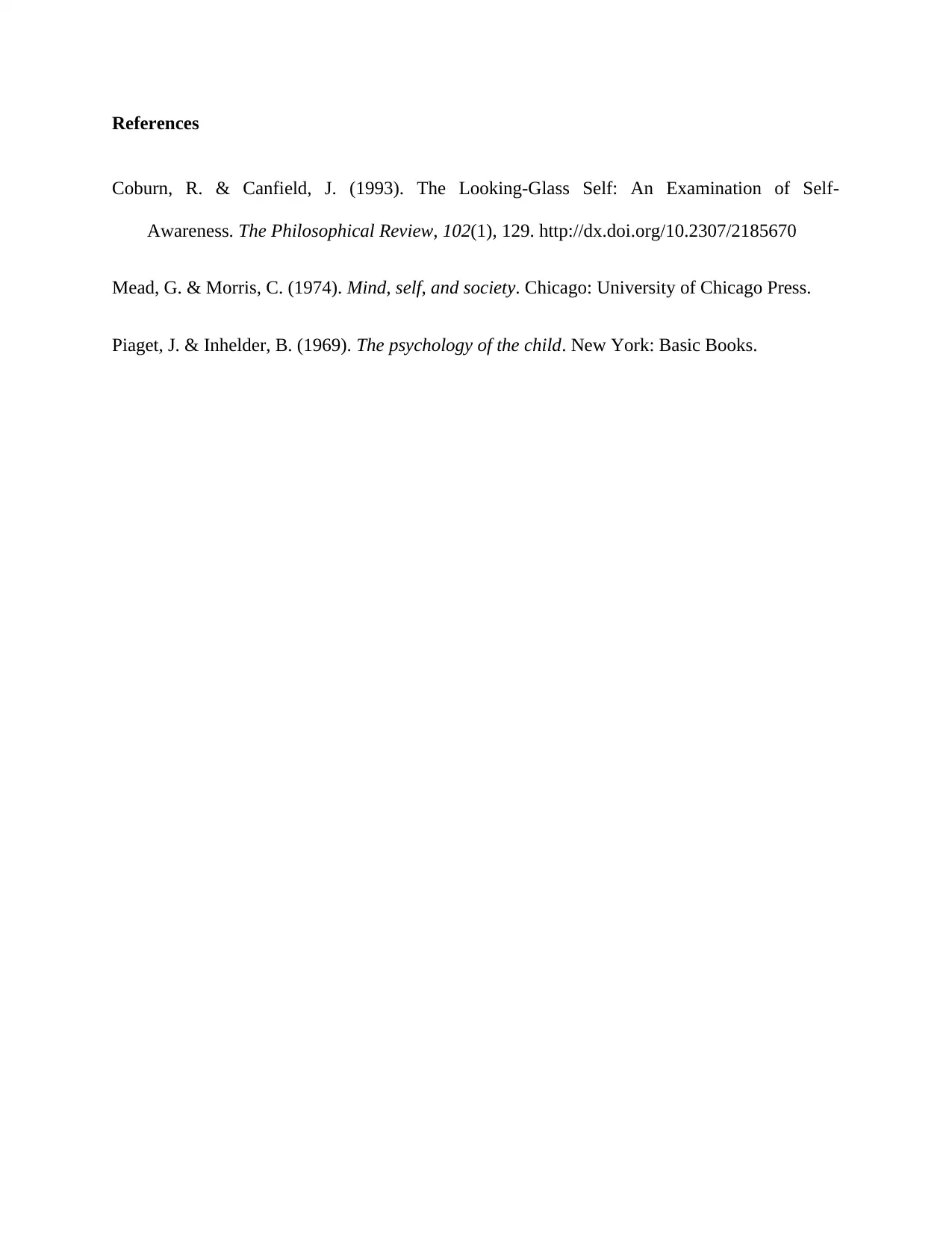Theories of Socialization: Cooley, Mead, and Piaget
VerifiedAdded on 2019/09/26
|4
|973
|266
Essay
AI Summary
This essay provides an overview of three prominent socialization theories: Charles Horton Cooley's "Looking-Glass Self," George Herbert Mead's "Theory of Social Self," and Jean Piaget's "Theory of Cognitive Development." The essay explains Cooley's concept of how individuals develop a self-image based on their perception of others' opinions, Mead's emphasis on the social construction of self through interaction, and Piaget's insights into the cognitive development of children. The essay discusses the key elements of each theory, their significance in understanding the development of the self, and the impact these theories have had on sociological thought. The essay concludes by suggesting that Piaget's theory provides the most useful insights into the development of self. References to relevant academic sources are also provided.

Socialization Theories
The process of the socialization refers to the fact that we learn to become competent members of
society. It is fundamentally centered upon the concept as to how self is developed. It provides an
idea how the sense of self emerges while living in the society and interacting with others. The
following paragraphs discuss three important theories of Socialization – Theory of Looking
Glass-Self (Charles Horton Cooley), Theory of Social Self (George Herbert Mead) and Theory
of Cognitive Development (Jean Piaget). Each of these theories are important in their own ways,
but it is up to us who we want to associate ourselves with.
According to the American sociologist Charles Horton Cooley, if a person displays a sense of
personal insecurity whenever he finds himself in the middle of a social construct then this state
of mind is only driven by what he believes what people think about him. Cooley came up with a
concept of the looking glass self, which tries to explain that a person’s self grows on the basis of
his interactions with the others. The central idea with which Cooley put across his views
underlines a person’s self-image. He believed that people tend to shape their self-concepts on the
basis of their understanding as to how people perceive them (Coburn & Canfield, 1993). Our
self-image reflects the responses and evaluations being made by others in our environment.
Cooley theorized that the process has three steps: we always imagine how we appear, we
imagine that what people would judge about us, and we imagine how a person feels about us. In
so far Looking glass-self theory is concerned, I am of the view that this theory paves a way for a
person to see or not to see himself in the consciousness of others who, he thinks, serve as mirrors
for reflecting his own image to himself.
George Herbert Mead famously propounded the “Theory of Social Self”, which underlines the
whole new meaning of self, me and I. He theorized that self consists of two elements self-
The process of the socialization refers to the fact that we learn to become competent members of
society. It is fundamentally centered upon the concept as to how self is developed. It provides an
idea how the sense of self emerges while living in the society and interacting with others. The
following paragraphs discuss three important theories of Socialization – Theory of Looking
Glass-Self (Charles Horton Cooley), Theory of Social Self (George Herbert Mead) and Theory
of Cognitive Development (Jean Piaget). Each of these theories are important in their own ways,
but it is up to us who we want to associate ourselves with.
According to the American sociologist Charles Horton Cooley, if a person displays a sense of
personal insecurity whenever he finds himself in the middle of a social construct then this state
of mind is only driven by what he believes what people think about him. Cooley came up with a
concept of the looking glass self, which tries to explain that a person’s self grows on the basis of
his interactions with the others. The central idea with which Cooley put across his views
underlines a person’s self-image. He believed that people tend to shape their self-concepts on the
basis of their understanding as to how people perceive them (Coburn & Canfield, 1993). Our
self-image reflects the responses and evaluations being made by others in our environment.
Cooley theorized that the process has three steps: we always imagine how we appear, we
imagine that what people would judge about us, and we imagine how a person feels about us. In
so far Looking glass-self theory is concerned, I am of the view that this theory paves a way for a
person to see or not to see himself in the consciousness of others who, he thinks, serve as mirrors
for reflecting his own image to himself.
George Herbert Mead famously propounded the “Theory of Social Self”, which underlines the
whole new meaning of self, me and I. He theorized that self consists of two elements self-
Paraphrase This Document
Need a fresh take? Get an instant paraphrase of this document with our AI Paraphraser

awareness and self-image. Interestingly, this theory of self is completely social and has no room
for the biological development of self and personality. He believed that our notion of self, who
we are and what our personality consists of etc. is constructed through interaction and being in
the world and also through the reflection by interacting more and more with the others and it
develops as we age and grow (Mead & Morris, 1974). It was Mead’s genius to see self
completely as a social phenomenon not a biological one. Mead also theorized that there are three
important elements that help in developing self – language, play and games. The two aspects of
self are me and I. Me denotes attitudes, behaviors and others’ expectations. I denotes an
individual’s identity in terms of response to me. So, I view this theory as a fascinating one
because it addresses everyone in the form of cohesive social elements.
Jean Piaget is one of the noted psychologists and sociologists, who famously proposed the theory
of Cognitive Development as to how children grow and develop intellectually in their childhood.
Piaget believed that children have a fundamentally different thinking as against the adults. He
was so intrigued with the way children gave reasons for their wrong answers that he realized that
their incorrect answers revealed very important aspects of their thinking. Piaget’s unparalleled
achievement was that he was a pioneer in making a systematic study of cognitive development in
which he incorporated detailed observational studies in order to find out cognition in children.
He carried out a series of simple but ingenious observational tests for revealing their various
cognitive abilities (Piaget & Inhelder, 1969). The results that Piaget got indicate that children
think in strikingly different ways compared to adults. As far as my views about Jean Piaget’s
theory are concerned, it is today an accepted notion that children think differently than adults,
but it was a revolutionary idea at that time. So, I believe that this was an important observation
and also inspired a lot of other theories to build their own theories on it.
for the biological development of self and personality. He believed that our notion of self, who
we are and what our personality consists of etc. is constructed through interaction and being in
the world and also through the reflection by interacting more and more with the others and it
develops as we age and grow (Mead & Morris, 1974). It was Mead’s genius to see self
completely as a social phenomenon not a biological one. Mead also theorized that there are three
important elements that help in developing self – language, play and games. The two aspects of
self are me and I. Me denotes attitudes, behaviors and others’ expectations. I denotes an
individual’s identity in terms of response to me. So, I view this theory as a fascinating one
because it addresses everyone in the form of cohesive social elements.
Jean Piaget is one of the noted psychologists and sociologists, who famously proposed the theory
of Cognitive Development as to how children grow and develop intellectually in their childhood.
Piaget believed that children have a fundamentally different thinking as against the adults. He
was so intrigued with the way children gave reasons for their wrong answers that he realized that
their incorrect answers revealed very important aspects of their thinking. Piaget’s unparalleled
achievement was that he was a pioneer in making a systematic study of cognitive development in
which he incorporated detailed observational studies in order to find out cognition in children.
He carried out a series of simple but ingenious observational tests for revealing their various
cognitive abilities (Piaget & Inhelder, 1969). The results that Piaget got indicate that children
think in strikingly different ways compared to adults. As far as my views about Jean Piaget’s
theory are concerned, it is today an accepted notion that children think differently than adults,
but it was a revolutionary idea at that time. So, I believe that this was an important observation
and also inspired a lot of other theories to build their own theories on it.

The three theories that we studied in the above passage became a bedrock for developing a social
conscience and inspired sociologists around the world to work towards the betterment of society.
Cooley explained the concept of looking glass-self in which he said that society is a person’s
self-image. Mead provided a deep insight of self, me and I. Whereas, Piaget made his invaluable
contribution towards the development of children by revealing that they think differently than
adults. However, I for one, have found Jean Piaget’s theory as the one that provides the most
useful insights into the development of the Self.
conscience and inspired sociologists around the world to work towards the betterment of society.
Cooley explained the concept of looking glass-self in which he said that society is a person’s
self-image. Mead provided a deep insight of self, me and I. Whereas, Piaget made his invaluable
contribution towards the development of children by revealing that they think differently than
adults. However, I for one, have found Jean Piaget’s theory as the one that provides the most
useful insights into the development of the Self.
⊘ This is a preview!⊘
Do you want full access?
Subscribe today to unlock all pages.

Trusted by 1+ million students worldwide

References
Coburn, R. & Canfield, J. (1993). The Looking-Glass Self: An Examination of Self-
Awareness. The Philosophical Review, 102(1), 129. http://dx.doi.org/10.2307/2185670
Mead, G. & Morris, C. (1974). Mind, self, and society. Chicago: University of Chicago Press.
Piaget, J. & Inhelder, B. (1969). The psychology of the child. New York: Basic Books.
Coburn, R. & Canfield, J. (1993). The Looking-Glass Self: An Examination of Self-
Awareness. The Philosophical Review, 102(1), 129. http://dx.doi.org/10.2307/2185670
Mead, G. & Morris, C. (1974). Mind, self, and society. Chicago: University of Chicago Press.
Piaget, J. & Inhelder, B. (1969). The psychology of the child. New York: Basic Books.
1 out of 4
Your All-in-One AI-Powered Toolkit for Academic Success.
+13062052269
info@desklib.com
Available 24*7 on WhatsApp / Email
![[object Object]](/_next/static/media/star-bottom.7253800d.svg)
Unlock your academic potential
© 2024 | Zucol Services PVT LTD | All rights reserved.

